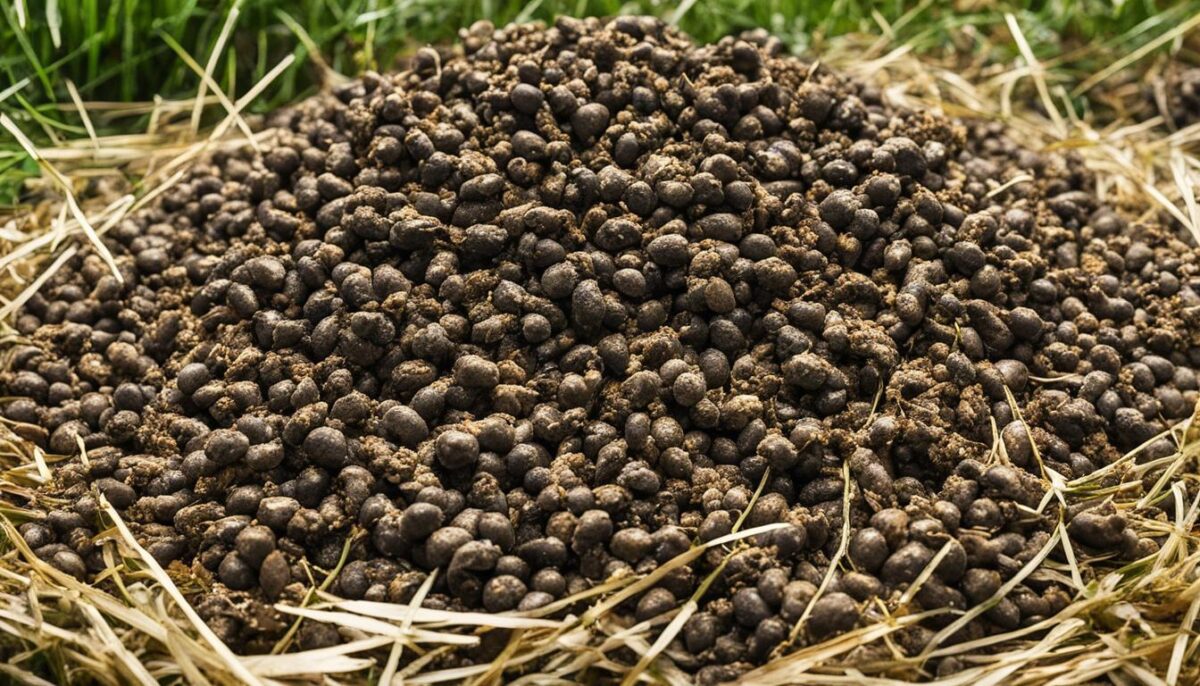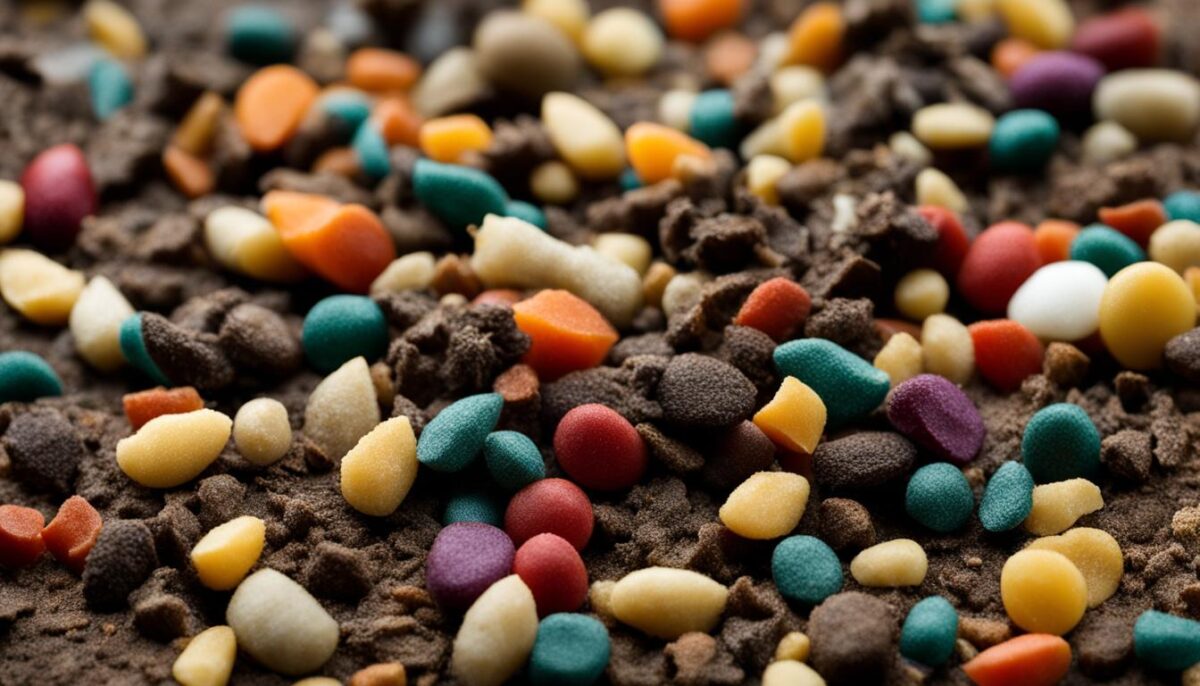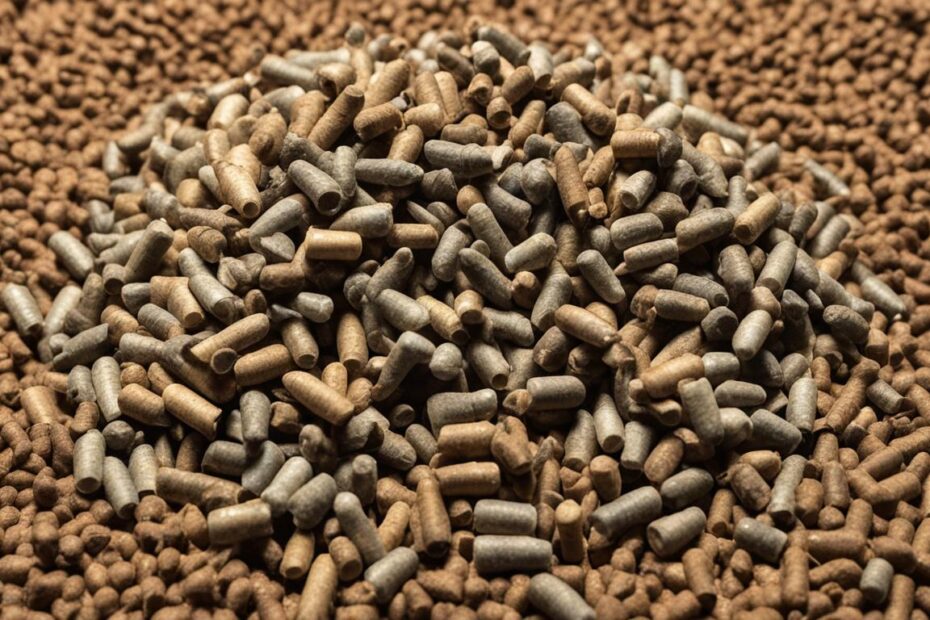Rabbits are fascinating pets that require specific care and attention, including monitoring their poop habits. While it may sound unusual, understanding your rabbit’s poop can provide valuable insights into their overall health and well-being.
Rabbits have a unique digestive system that produces a lot of poop, but fear not, it’s not as gross as it may seem. Their poop, also known as fecal pellets, is dry, odorless, and resembles small cocoa puffs. Monitoring their poop is essential because any changes in consistency, color, or size can indicate potential health issues.
Normal rabbit poop should be consistent in size and color, ranging from the size of a green pea to a chickpea. It should be round, hard, and uniform. However, there’s more to rabbit waste than meets the eye. Rabbits also produce cecotropes, nutrient-packed soft pellets that they consume for added nutrition.
Key Takeaways:
- Monitoring your rabbit’s poop is vital for their overall health.
- Normal rabbit poop should be consistent in size, color, and shape.
- Cecotropes are soft, nutrient-packed pellets that rabbits consume for added nutrients.
- Changes in poop consistency, color, or size can indicate potential health issues.
- Consult with a veterinarian if you notice any abnormal poop characteristics.
What Healthy Rabbit Poop Looks Like
When it comes to rabbit poop, the health and appearance of their droppings can provide valuable insights into their overall well-being. Healthy rabbit poop, also known as fecal pellets, should exhibit specific characteristics that indicate a well-functioning digestive system and good nutrition.
Healthy rabbit droppings should be:
- Round and dry
- Composed mostly of hay
- Uniform in size and color within an individual rabbit
- Range in color from dark brown to a wheat-colored shade
- Hard to the touch, resembling dusty, digested hay
- Odorless
It’s important to note that there may be variations in the color and size of rabbit droppings among different rabbits. Thus, it is crucial to establish what is normal for your specific rabbit. By monitoring their poop habits regularly, you can quickly identify any changes that may signal an underlying health problem.
Detailed Characteristics of Healthy Rabbit Poop
Let’s take a closer look at the detailed characteristics of healthy rabbit poop:
| Characteristic | Description |
|---|---|
| Shape | Round |
| Consistency | Dry |
| Composition | Mainly hay |
| Size | Varies, but uniform within an individual rabbit |
| Color | Range from dark brown to wheat-colored |
| Texture | Hard, resembling dusty, digested hay |
| Smell | Odorless |
By paying attention to the appearance of your rabbit’s droppings and making sure they exhibit these characteristics, you can ensure that they have a healthy digestive system and are receiving the proper nutrition they need to thrive.

Cecotropes are usually eaten directly by rabbits, so they are not commonly found lying around. If you do come across cecotropes, it may indicate a need to adjust your rabbit’s diet, as overproduction can occur when there is too much sugar in their food.
Cecotropes are typically produced in the evening, although the timing can vary among rabbits.
When Rabbit Poop Gets Strange
Rabbit poop is an essential indicator of their overall health. Monitoring their droppings can provide insights into potential health issues. Abnormal rabbit droppings can vary in form and appearance, signifying underlying problems that require attention. Here are some abnormal rabbit poop characteristics to be aware of:
- Diarrhea: Watery and shapeless poop is a cause for concern and may indicate an issue. This can be caused by factors such as diet, inappropriate antibiotic use, toxins, or underlying diseases.
- Poop strung together by fur: During shedding seasons, it’s normal for rabbit droppings to be strung together by fur, resembling a string of pearls. However, excessive production of fur-coated droppings may lead to hair blockages, necessitating additional grooming to prevent complications.
- Double poops: When two or three droppings merge, it suggests a temporary slowdown in gut movement. While it may not necessarily indicate a health problem, keeping an eye on the consistency is important.
- Small, hard, and dry poop: If your rabbit’s droppings are small, hard, and dry, it might be a sign of dehydration or stress. Ensure your rabbit has access to fresh water at all times and evaluate their environment for potential stressors.
- Mucus in poop: The presence of mucus in rabbit droppings can be an indication of gut irritation. This can be caused by factors such as antibiotics, pain medications, or dental issues. It’s essential to consult with a rabbit-savvy veterinarian to address any underlying concerns.
Remember, any major changes in rabbit poop characteristics should be discussed with a veterinarian specializing in rabbit care. They can provide proper diagnosis and treatment to ensure your rabbit’s well-being.

Quote:
“Abnormal rabbit droppings can be a telltale sign of underlying health issues. Paying close attention to your rabbit’s poop can help you identify potential problems early on and take appropriate action.” – Dr. Sarah Johnson, Rabbit Specialist
| Abnormal Rabbit Dropping | Possible Causes |
|---|---|
| Diarrhea | Diet, inappropriate antibiotic use, toxins, underlying diseases |
| Poop strung together by fur | Excessive fur ingestion during shedding seasons |
| Double poops | Temporary slowdown in gut movement |
| Small, hard, and dry poop | Dehydration, stress |
| Mucus in poop | Gut irritation caused by antibiotics, pain medications, dental issues |
Managing Rabbit Poop and Toileting Habits
To ensure proper hygiene and manage rabbit poop effectively, it’s important to establish a suitable litter box and monitor your rabbit’s toileting habits. Rabbits are naturally clean animals and prefer having designated areas for sleeping, eating, and relieving themselves. In this section, we’ll explore some strategies to promote good rabbit hygiene and maintain a clean living environment.
Providing a Suitable Litter Box
Choosing the right litter box for your rabbit is crucial for successful and hassle-free litter training. Opt for a litter box that is spacious enough for your rabbit to comfortably move around in. It should have low sides for easy access and preferably be made of a durable, non-toxic material.
Line the litter box with a layer of rabbit-safe litter material such as paper-based pellet litter, wood shavings, or hay. Avoid using clay or clumping litter as they can be harmful if ingested by your rabbit. The litter should be absorbent and odor-controlling to keep the litter box smelling fresh.
Place the litter box in an area where your rabbit feels safe and secure, such as a quiet corner of their enclosure or a designated room. Rabbits prefer privacy while toileting, so ensure the litter box is not in a high-traffic area or near their food and water bowls.
Monitoring Toileting Habits
Observe your rabbit’s toileting habits to identify any changes or issues that may arise. Most rabbits develop a preference for a specific toileting area, so it’s essential to place the litter box in their chosen spot. If your rabbit starts eliminating outside of the litter box, it could be due to its location, feeling exposed, or experiencing environmental stress.
Regularly clean the litter box to maintain optimal hygiene and prevent odor buildup. Remove soiled litter and replace it with fresh litter as needed. Spot cleaning should be done daily, while a complete litter box change is recommended at least once a week.
Grooming to Prevent Stringy Poop
Rabbits tend to ingest fur while grooming themselves, which can result in the formation of stringy poop. Excessive fur ingestion can lead to hair blockages and digestive issues. To prevent this, regular grooming is essential.
During shedding seasons, use a rabbit-safe brush or comb to remove loose fur from your rabbit’s coat. This helps minimize the amount of fur ingested and reduces the likelihood of stringy poop. Additionally, providing your rabbit with plenty of hay can help in naturally reducing fur ingestion.
Consulting a Veterinarian
If you notice your rabbit not producing droppings or experiencing changes in their toileting behavior, it is important to consult with a rabbit-savvy veterinarian. These changes could be indications of underlying health conditions that require medical attention. A veterinarian with expertise in rabbit care can provide guidance and advice tailored to your rabbit’s specific needs.
By implementing these strategies, you can effectively manage rabbit poop and promote good hygiene. Remember to provide a suitable litter box, monitor your rabbit’s toileting habits, groom them regularly, and seek veterinary assistance when needed. By maintaining a clean and healthy living environment for your rabbit, you can ensure their well-being and happiness.
Conclusion
Monitoring your rabbit’s poop is crucial for maintaining their overall health and well-being. By familiarizing yourself with their normal poop characteristics, you can quickly identify any changes that may indicate an underlying health problem. Healthy rabbit poop should be round, dry, and consistent in size and color.
Cecotropes are soft, nutrient-rich pellets that rabbits consume for added nutrition. If you notice any abnormal poop characteristics, such as diarrhea, stringy poop, or changes in size, shape, or color, it is important to discuss them with a veterinarian. They can help determine the cause and provide appropriate treatment or guidance.
By staying vigilant and proactive about your rabbit’s poop habits, you can ensure their health and happiness. Regularly monitor their poop and be alert to any signs of illness. If you have any concerns about your rabbit’s poop or overall health, don’t hesitate to reach out to a rabbit-savvy veterinarian. Remember, a healthy poop means a healthy rabbit!
FAQ
Why is it important to monitor my rabbit’s poop?
Monitoring your rabbit’s poop is important as it can indicate their overall health. Changes in poop consistency, color, or size can be signs of illness and should be monitored closely.
What does healthy rabbit poop look like?
Healthy rabbit poop, also known as fecal pellets, should be round, dry, and composed mostly of hay. The size of the pellets can vary, but they should be uniform in size and color within an individual rabbit. The color can range from dark brown to a wheat-colored shade. Texture-wise, the pellets should be hard to the touch, resembling dusty, digested hay. Healthy rabbit poop does not have a strong smell.
What are cecotropes?
Cecotropes are soft, nutrient-packed pellets that rabbits produce in their cecum. They are usually eaten directly by rabbits for added nutrients. If you come across cecotropes, it may indicate a need to adjust your rabbit’s diet.
What are the signs of abnormal rabbit poop?
Abnormal rabbit poop can take on various forms. Diarrhea, poop strung together by fur, double poops, small and dry poop, and mucus in poop are all signs of potential health issues and should be discussed with a veterinarian.
How can I manage my rabbit’s poop and toileting habits?
To manage rabbit poop and promote good hygiene, provide a suitable litter box and monitor your rabbit’s toileting habits. Observing your rabbit’s preferred toileting area and placing a litter box there can encourage proper usage. Regular grooming can help prevent excessive fur ingestion and stringy poop production.
Why should I consult a veterinarian if there are changes in my rabbit’s poop?
Any major changes in poop characteristics should be discussed with a rabbit-savvy veterinarian. They can help determine if there are underlying health issues or if any adjustments are needed.


